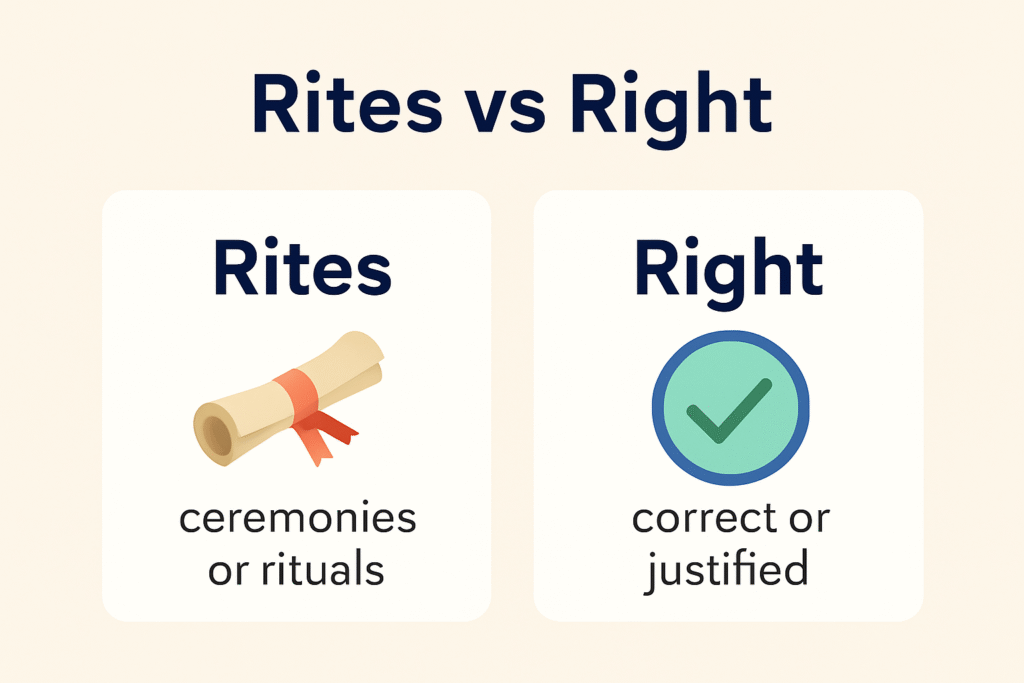Rites vs Right: Spot the Difference

The word pair rites vs right can be confusing, especially when spoken aloud. These words are homophones they sound the same but have very different meanings and uses in writing. While “right” is far more common in everyday English, “rites” appears mostly in cultural, religious, or ceremonial contexts.
Understanding the difference between rites vs right helps writers avoid unintentional errors. Whether you’re describing a ritual or making a moral judgment, choosing the correct word matters.
This article will explain the grammar, meaning, and usage of rites vs right, complete with real-life examples, common mistakes, and memory tips to help you remember which is which.
Grammatical Explanation of Rites vs Right
Let’s examine the grammar behind rites and right:
- Rites is a plural noun that refers to formal ceremonies or rituals, especially those related to religion, culture, or tradition.
Example: The funeral rites were performed according to custom. - Right has multiple grammatical roles:
- Adjective (correct or proper): That’s the right answer.
- Noun (a moral or legal entitlement): Everyone has the right to vote.
- Adverb (exactly or immediately): She was right behind you.
- Verb (to correct something): He tried to right the wrong.
The two words serve entirely different purposes. When comparing rites vs right, remember that “rites” refers to ceremonies, while “right” can refer to correctness, direction, fairness, or actions.
Real-Life Examples of Rites vs Right
Here are practical examples that clarify the usage of rites and right:
Rites (ceremonies or rituals):
- Initiation rites are important in many tribal communities.
- The priest performed the marriage rites with great care.
Incorrect: She went through the right of passage.
Correct: She went through the rite of passage.
Right (correct or justified):
- You were right about the weather forecast.
- It’s your right to speak freely.
Incorrect: They conducted the religious rights last night.
Correct: They conducted the religious rites last night.
Understanding rites vs right ensures you don’t accidentally refer to a ceremony as a direction or a legal entitlement as a ritual.
Common Mistakes
The most frequent mistake with rites vs right is confusing the plural noun “rites” with the more commonly used “right.” Since “right” has many meanings, writers often default to it, even when referring to rituals or ceremonies.
- He was honored with the last rights.
He was honored with the last rites. (This refers to a religious ceremony.)
Another common error is misusing “right of passage” instead of “rite of passage.” The correct term refers to a formal transition or initiation ceremony.
To avoid these mistakes, always consider the context. If you’re talking about customs, traditions, or formal acts, you likely need “rites.” If you’re referring to correctness, entitlements, or directions, you likely mean “right.”
Memory Tips
Here are quick tips to remember the difference between rites vs right:
- Rites = Rituals
Think: “rites and rituals” both start with “R” and are used in religious or cultural contexts.
Example: The initiation rites were ancient traditions. - Right = Correct / Entitled
Think: Right is what’s right to do. It can refer to fairness, direction, or correctness.
Mnemonic device:
- If it involves a ceremony, pick rites.
- If it involves justice, directions, or correctness, choose right.
Understanding these tips will help you confidently choose between rites vs right every time you write.
Conclusion
The distinction between rites and right is all about context. Use “rites” when referring to formal ceremonies, and “right” when expressing something correct, just, or directional. Being able to tell the difference ensures your message is accurate and professional.
Want to improve your grammar further? Check out our blog on Grammar/Usage Confusion another commonly confused word pair.
For more examples and deeper usage, see Merriam-Webster’s entry on rite.